Dermatitis is inflammation of the skin causing symptoms like redness, itching, peeling, and blisters. Dermatitis can appear in different parts of the body and can affect people of all ages.
Dermatitis can be caused by coming into contact with substances or fabrics that provoke an allergic reaction. Dermatitis may also be a side effect of certain medications or result from poor circulation or very dry skin.
Treatment of dermatitis is managed by a primary care provider or dermatologist based on the type of condition, and may involve the use of creams, ointments, allergy medications, corticosteroids, or shampoos.
Types and symptoms
Dermatitis presents with different symptoms based on the cause of the condition. The main types of dermatitis are:
1. Atopic dermatitis
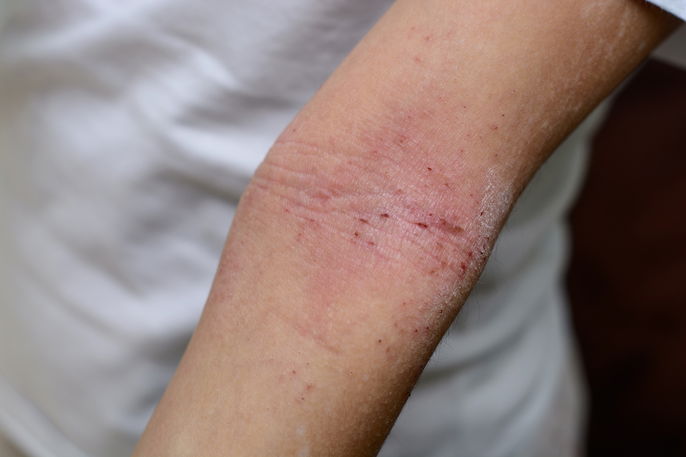
Atopic dermatitis is more common in babies and children under 5 years of age and is characterized by red and/or grayish lesions that cause itching and peeling of the skin. It typically affects the knees, neck, groin, elbows, and arm folds.
While the exact cause of atopic dermatitis is unknown, it is usually seen in people with a family history of this condition or in those who have asthma or allergic rhinitis.
2. Contact dermatitis
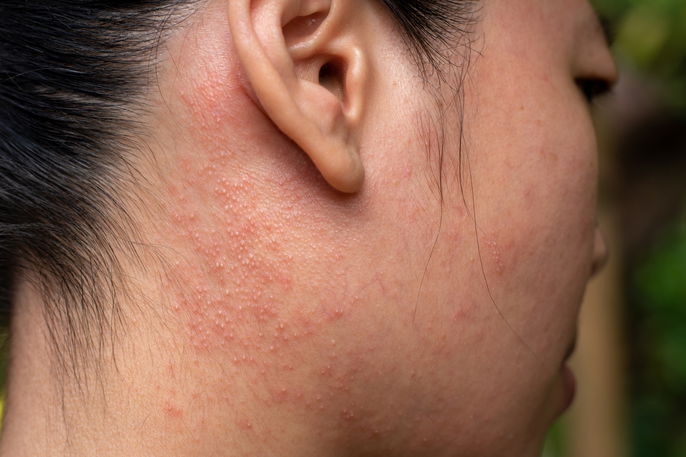
Contact dermatitis, which includes allergic and irritant contact dermatitis, causes blisters, itchy skin, and redness and can affect any part of the body, including the ears, face, scalp, eyelids, neck, underarms, and hands.
Contact dermatitis can be caused by coming into contact with irritating substances like nickel, cosmetics, perfumes, dust, soaps, detergents, or latex.
3. Seborrheic dermatitis
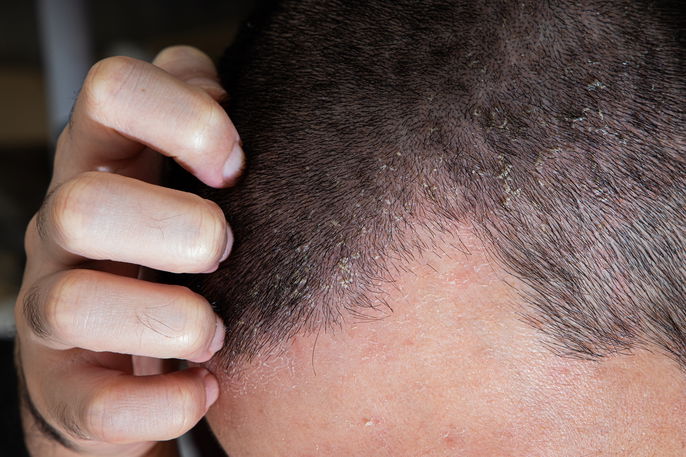
Seborrheic dermatitis primarily affects the scalp and other oily regions of the body, like the sides of the nose, the face, the ears, the beard, the eyelids, and the chest, causing redness, scaly patches, and peeling of the skin.
This type of dermatitis is believed to be associated with the presence of a specific genus of fungi (yeast) called Malassezia that is normally present on the skin. An overabundance of Malassezia may be to blame in people with a family history of seborrheic dermatitis or those suffering from stress or other skin diseases like rosacea, psoriasis, and acne.
4. Perioral dermatitis

This type of dermatitis causes red, pus-filled bumps to appear around the mouth as well as itchiness and a burning sensation. While perioral dermatitis is more common around the mouth, the rash can also appear on the eyelids, cheeks, and around the nose or eyes.
Perioral dermatitis is more common in women between 20 and 45 years of age. While the exact cause is still unknown, it is believed to be associated with the use of corticosteroid creams and sprays as well as alterations in the normal skin flora.
5. Stasis dermatitis
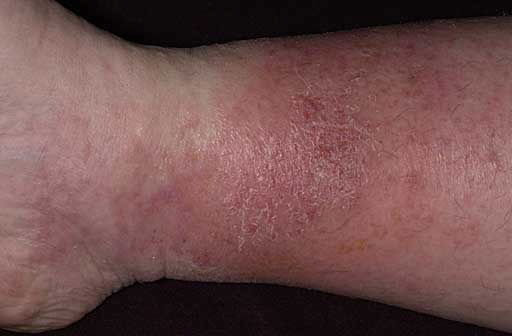
Stasis dermatitis typically occurs in people with venous insufficiency, a condition in which the veins in the legs have trouble sending the blood back up to the heart, causing blood to pool in the legs.
The main symptoms of stasis dermatitis are swelling of the legs and ankles and localized itching and discoloration of the skin, usually a purplish-brown color. Wounds (ulcers) can also develop that may ooze and form a crust.
6. Dermatitis herpetiformis
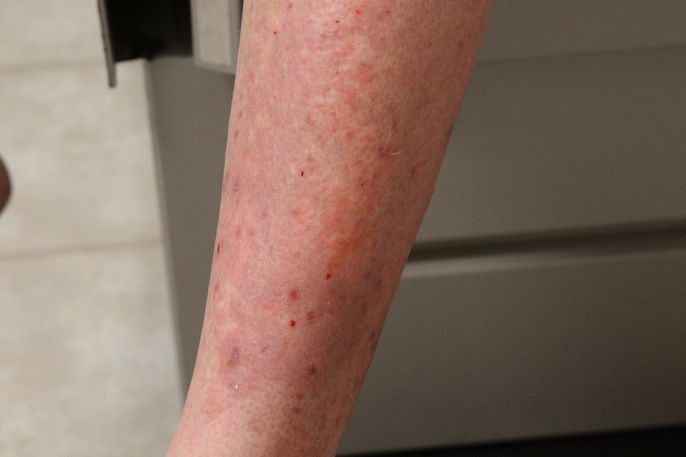
Dermatitis herpetiformis is an autoimmune condition caused by gluten intolerance that causes symptoms like small red blisters that itch and burn.
This type of dermatitis more often affects the scalp, shoulders, buttocks, elbows, and knees.
7. Diaper dermatitis
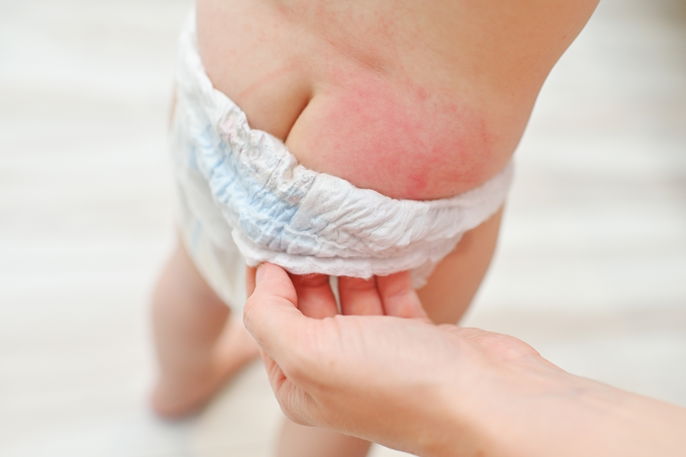
Also known as diaper rash, diaper dermatitis can appear on a baby's groin, thighs, scrotum, and buttocks and is characterized by bumps, redness, and peeling of the skin.
This type of dermatitis can be caused by moisture, allergies, friction, or contact with feces or urine for long periods of time.
8. Exfoliative dermatitis
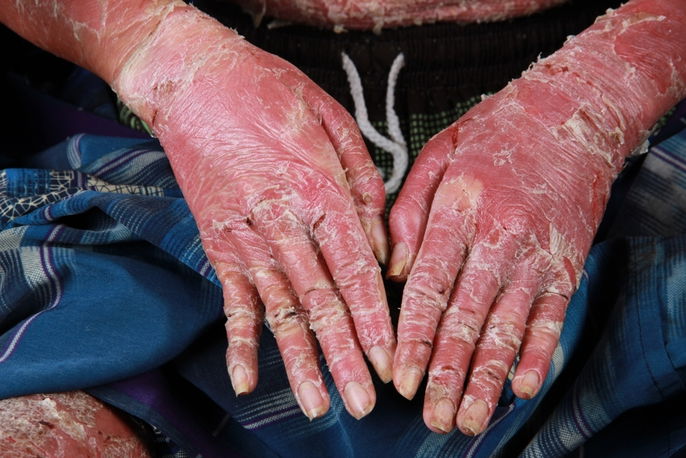
Exfoliative dermatitis is a severe inflammation of the skin causing peeling of the skin; red, shiny patches on the chest, arms, feet, or legs; hair loss in the affected regions; brittle nails; and a temperature over 100.4°F (38°C).
This type of dermatitis may be caused by other skin problems, like psoriasis or eczema, but can also be caused by the use of certain medications like antibiotics, antiepileptics, lithium, and allopurinol.
9. Nummular dermatitis
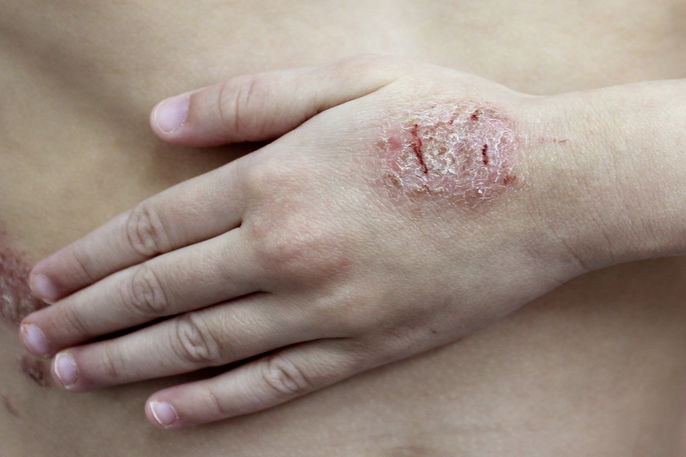
Nummular dermatitis, or nummular eczema, is characterized by itchy round patches that are red, pink, or brown in color. These patches often evolve into blisters that can ooze and eventually form crusts. It is more common on the arms, legs, hands, and trunk.
While the exact cause is unknown, it is believed to be related to allergies, bacterial infections, extremely dry skin, hot showers, and the use of soaps and other products that dry out the skin.
10. Moth dermatitis
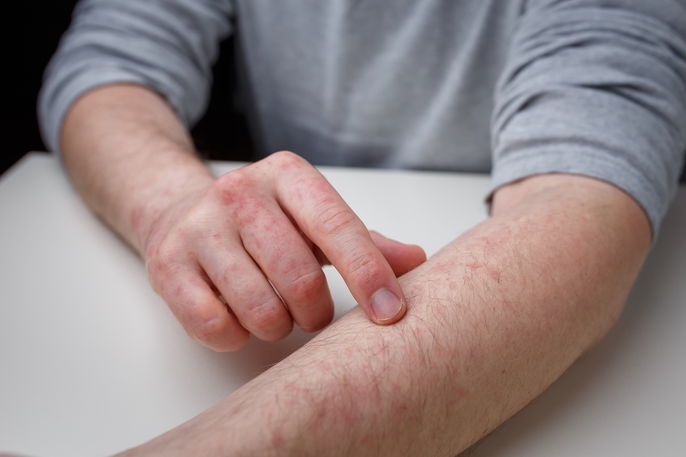
Moth dermatitis is caused by the Hyelsia species of moth that is active at night and sheds bristles that can deeply penetrate the skin and cause intense itching and localized redness.
Symptom checker
Use the symptom checker below to see if your symptoms might be caused by dermatitis (select all that apply):
This symptom checker is only a tool and should not be interpreted as medical advice. It should not be used to diagnose any condition or take the place of a consultation with a dermatologist or your primary care provider.
Confirming a diagnosis
A primary care provider or dermatologist diagnoses dermatitis based on the results of a physical exam and individual and family history.
To confirm a diagnosis, your provider may also order tests like a skin biopsy, allergy test, or blood tests to check thyroid function and IgE levels, a protein that, when elevated, is associated with allergies.
Common causes
The main causes of dermatitis include:
- Allergies to pollen, cosmetics, latex, or insect bites;
- Medication side effects;
- Exposure to cigarette smoke or pollution;
- Hot showers;
- Contact with synthetic fabrics;
- Cleaning products, like detergents or disinfectants;
- Depression;
- Changes in the weather;
- Gluten intolerance;
- Use of soaps, shampoos, and perfumes;
- Genetic factors;
- Hair products containing formaldehyde or p-Phenylenediamine (PPD).
In addition, dermatitis can also be caused by poor circulation or by the use of antibiotic or corticosteroid creams, ointments, or sprays.
Treatment options
Treatment of dermatitis will vary based on the cause of the condition, and may include diet changes and the use of oral medications, creams, and shampoos.
1. Ointments and creams
Topical antihistamines or corticosteroids, like clobetasol propionate, triamcinolone, or dexamethasone, may be prescribed to reduce skin inflammation and alleviate symptoms of atopic dermatitis, contact dermatitis, seborrheic dermatitis, dermatitis herpetiformis, and exfoliative dermatitis.
Emollients and urea creams may also be indicated to help treat atopic dermatitis, contact dermatitis, and exfoliative dermatitis.
For the treatment of diaper dermatitis, your pediatrician may prescribe ointments that contain zinc to be used in the affected area to protect the baby's skin and help it heal.
2. Shampoos
Shampoos containing corticosteroids like hydrocortisone, fluocinolone, clobetasol, or desonide are generally indicated for the relief of symptoms of seborrheic dermatitis.
See seborrheic dermatitis treatment.
3. Medications
Medications like oral corticosteroids and antihistamines may be prescribed by your provider to relieve itching and inflammation caused by atopic dermatitis and contact dermatitis. Treatment of exfoliative dermatitis will likely involve administering corticosteroids directly into a vein (through an IV) in the hospital.
In the case of stasis dermatitis, your provider may also recommend medications containing hesperidin and diosmin to treat symptoms caused by venous insufficiency.
Oral antibiotics may also be indicated for the treatment of stasis dermatitis, dermatitis herpetiformis, and perioral dermatitis.
4. Diet
Treatment of dermatitis herpetiformis involves a low-gluten or gluten-free diet that avoids wheat, barley, and oats. For treatment of atopic dermatitis, it is recommended to eliminate any allergy-causing foods like shrimp, peanuts, or milk.
5. Rest
Rest is indicated in the case of stasis dermatitis, as well as wearing compression stockings and keeping the feet elevated to prevent blood from pooling in the legs.
Care tips
While being treated for dermatitis it is important to:
- Avoid contact with materials or substances that cause a skin reaction;
- Take warm (not hot) showers;
- Avoid scratching the affected area;
- Use neutral soaps and detergents;
- Avoid using perfumes.
It is also recommended to avoid alcoholic beverages and foods high in fat and sugar, like fried foods, cookies, and ice cream, as these foods can trigger inflammation and make it difficult for the skin to heal.






























